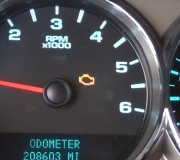That is not any type of solution. There are well over 2,000 potential defects that can be detected. About half of them relate to things that could adversely affect emissions. Those are the diagnostic fault codes that turn on the Check Engine light. Until you have the fault codes read and recorded, it is impossible to know where to look for the cause of the problem.
Also be aware that those fault codes never say to replace a part or that one is defective. They only indicate the circuit or system that needs further diagnosis, or the unacceptable operating condition. When a sensor or other part is referenced in a fault code, it is actually the cause of that code only about half of the time. First we have to rule out wiring and connector terminal problems, and mechanical problems associated with that part.
There's two other problems with unplugging a sensor. The first is that is going to be detected and a fault code is going to set for that. Your mechanic needs to read the codes to know where to start the diagnosis, and that code you caused is going to confuse the issue. He could go looking for that and find the unplugged sensor, then assume the problem has been solved.
The bigger problem is for a fault code to set, there is always a real long list of conditions that must be met. That list always includes that certain other codes can't already be set. For example, the Engine Computer knows that when the engine has been off for at least six hours, the intake air temperature sensor and the coolant temperature sensor had better be reading the same temperature. If they are significantly different, it has strategies for figuring out which one is wrong, then it sets the appropriate fault code.
Now if you've unplugged the coolant temperature sensor, the computer will see that open circuit, and the default temperature on most vehicles is minus 40 degrees Fahrenheit. It knows that sensor can not be trusted for use as a reference when testing the intake air temperature sensor, so that is one of many tests that will be suspended. Except for a serious circuit malfunction, if a relatively minor problem develops in the intake air temperature sensor's circuit, it will go undetected, but it could cause a miserable engine performance problem. Without the fault code for the intake air temperature sensor, the mechanic would have no way of knowing there was a problem in that circuit. He would have to diagnose and repair the problem with the coolant temperature sensor circuit first, erase that fault code, at which time the suspended tests will resume, go out and drive the vehicle, then, when the problem with the intake air temperature sensor is finally detected, the fault code will set for that problem, the Check Engine light turns on again, and then he will see the next circuit that needs to be diagnosed.
We already run into this problem on a regular basis and it's frustrating for us and for our customers. This is more of a problem when people wait a long time to get the vehicle looked at after the Check Engine light initially turned on. That gives more time for a second or third totally unrelated problem to develop. All the mechanic has to go on is the fault code currently in memory when he works up an estimate for the repair. He has no way of knowing more problems exist that are going to pop up after he completes the first repair. That's when he has to find the owner and tell them more diagnosis is needed. We hate having to do that, and customers incorrectly assume we diagnosed the problem improperly or repaired it improperly.
Very often that Check Engine light turning right back on occurs just as the owner is driving out of the repair shop's parking lot, or before they get a few miles away. It's only natural to assume it is due to the same problem, then when we look into it and find there was that second undetected problem, we aren't believed. This happens all the time with GM truck anti-lock brakes. Many of those computers can only store one fault code at a time. Add to that there are many common problems with multiple problems occurring at nearly the same time, especially for wheel speed sensors, and it's quite often we repair a problem, then the next one shows up right after that.
There's one more problem to be aware of when you already know what the fault code is for. With many of the potential problems, you can still drive the vehicle when you know it will not lead to a more serious problem, but some minor problems do turn serious, especially if they lead to overheating the very expensive catalytic converter in the exhaust system. With the Check Engine light already on for that minor problem you're aware of, how will you know when that second, potentially serious problem develops? The light is already on, so there's no way to know another problem occurred. The only exception is when the defect results in too much unburned fuel going into the exhaust system, the Check Engine light will start flashing. That tells you to stop the engine as soon as possible to prevent that costly damage to the catalytic converter.
Beyond all this, if you're going to drive the vehicle until you can get it to the shop, don't unplug anything. Doing so will just add more problems.
Saturday, January 11th, 2020 AT 6:11 PM




